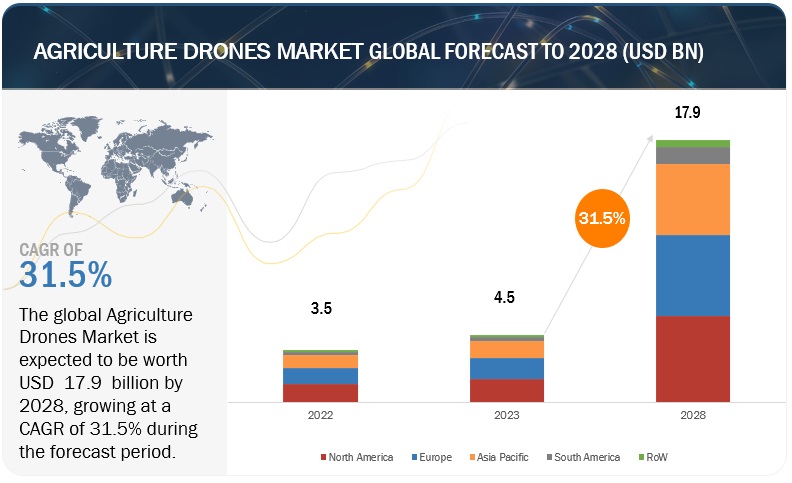The agriculture drones market size is predicted to grow at a CAGR of 31.5% between 2023 and 2028, reaching a value of $17.9 billion by 2028 from a projection of $4.5 billion in 2023. Drone technologies are quickly revolutionizing the agricultural sector owing to the recent evolutions in this technology and the Federal Aviation Administration (FAA) regulations, thereby bringing drones into mainstream farming. With the global population projected to reach over 9 billion by 2050, the consumption of agricultural products is expected to increase by 70%, a figure complicated by unpredictable weather patterns and natural disasters.

What are agriculture drones?
Agriculture drones, also known as agricultural UAVs (Unmanned Aerial Vehicles) or ag drones, are remotely piloted or autonomous aerial vehicles designed specifically for use in farming and agriculture. These drones are equipped with various sensors, cameras, and other technologies to collect data and perform tasks aimed at improving crop management, yield optimization, and overall farm efficiency. Agriculture drones have gained popularity due to their ability to provide farmers with valuable insights and data-driven solutions.
Key features and applications of agriculture drones include:
Remote Sensing: Drones can carry sensors that capture data such as infrared imagery, multispectral images, and thermal images. These data can be used to assess crop health, identify areas with pest infestations or diseases, and monitor overall plant conditions.
Precision Agriculture: Drones enable precision farming by allowing farmers to target specific areas of their fields with the precise application of resources like fertilizers, pesticides, and water. This targeted approach helps optimize resource usage and reduce environmental impact.
Mapping and Surveying: Drones equipped with mapping and surveying tools can create detailed 3D maps of the farmland. This information aids in better land management, irrigation planning, and drainage optimization.
Crop Monitoring: Drones can regularly monitor crop growth and development, providing real-time data on crop health and identifying potential issues early on. This helps farmers make informed decisions regarding irrigation, nutrient application, and pest control.
Planting and Seeding: Some specialized drones are designed for planting seeds in a precise and controlled manner. This can enhance the efficiency of the planting process and contribute to optimal spacing and germination.
Livestock Monitoring: Drones are also used in livestock management by providing aerial views for monitoring herd health, assessing pasture conditions, and identifying potential issues in the field.
Weather and Climate Monitoring: Drones equipped with weather sensors can collect data on temperature, humidity, and other atmospheric conditions. This information is valuable for understanding local weather patterns and making informed decisions about crop management.
Agriculture Drone Market Trends
Precision Agriculture Adoption: Agriculture drones were increasingly being used for precision farming. These drones are equipped with various sensors and imaging technologies, such as NDVI (Normalized Difference Vegetation Index) cameras, to monitor crop health, assess soil conditions, and optimize resource utilization.
Automation and AI Integration: Drones with advanced automation features and artificial intelligence (AI) integration were gaining popularity. These capabilities allowed drones to autonomously navigate fields, analyze data in real-time, and make informed decisions for optimizing farming practices.
Data Analytics and Decision Support: The emphasis was on leveraging the vast amounts of data collected by agriculture drones. Data analytics tools and platforms were being used to process drone-collected information, providing farmers with valuable insights for better decision-making in areas such as crop management, yield prediction, and resource allocation.
Crop Monitoring and Disease Detection: Agriculture drones were increasingly employed for crop monitoring and early detection of diseases. High-resolution imagery and sensors allowed farmers to identify potential issues in crops, enabling timely interventions to prevent widespread damage.
Integration with Other Technologies: Agriculture drones were being integrated with other emerging technologies such as Internet of Things (IoT) devices, satellite imaging, and farm management software. This integration aimed to create a comprehensive and interconnected farming ecosystem.
Regulatory Developments: The regulatory environment for drone usage in agriculture was evolving. Governments were working on defining guidelines and regulations to ensure safe and responsible drone operations in agricultural settings. Compliance with these regulations became a significant consideration for industry players.
Customization for Specific Crops: Drone manufacturers were focusing on designing specialized drones tailored to the needs of specific crops. Different crops may require unique monitoring parameters and sensing technologies, leading to the development of customized drone solutions.
Agriculture Drone Market Driver: Availability of software solutions for field survey and data analytics
Software in drones acts as an interface for mediating the interaction between user and aircraft, and aircraft and its hardware. Similar to smartphones and tablet systems, choosing the wrong software platform for any drone can result in high switching costs if one needs to change the software in the future. Drone software is categorized as open source and proprietary software. Open-source software is distributed under a variety of licensing terms; almost anyone can modify the software to add capabilities that are not envisaged by its originators. Hence, it is preferred over proprietary software.
PX4 is one of the top open-source, auto-piloting software packages available from Pixhawk (Switzerland) in the agriculture drone sector. It is a piece of software that allows drones and other unmanned vehicles to fly. The software offers drone developers a versatile set of tools for sharing technology and creating customized solutions for drone applications. Farm surveying plays an important role in precision farming, along with proper analysis of field data collected by drones.
Agriculture Drones Market Share
The key players in this include DJI (China), PrecisionHawk (US), Trimble Inc. (US), Parrot Drones (France), AeroVironment, Inc. (US), Yamaha Motor Co., Ltd. (Japan), AgEagle Aerial Systems, Inc. (US), DroneDeploy (US), 3DR (US), and Sentera Inc. (US) SlantRange (US), Sentera Inc. (US), ATMOS UAV (Netherlands), Delair (France), and Nileworks Inc. (Japan).
The Asia Pacific market is projected to contribute the largest share of the agriculture drones market.
APAC is among the prospective markets for agriculture drones. APAC has large farmlands and a high population growth rate. APAC has a huge regional spread with countries such as China, Japan, India, Australia, New Zealand, and the Rest of APAC. In APAC, the adoption of agriculture drones is driven by factors such as the rising food demand, the need to improve yields despite limited resources, and the growing necessity to protect crops from unpredictable weather conditions.
Key Questions Addressed by Agriculture Drone Market Report:
1. What are the drivers for the growth of the agriculture drones market?
2. Which are the major companies in the agriculture drones market? What are their major strategies to strengthen their market presence?
3. Which region is expected to hold the highest share in the agriculture drones market?
4. Which are the key technology trends prevailing in the agriculture drones market?
5. What is the total CAGR expected to be recorded for the agriculture drones market during 2023-2028?
About MarketsandMarkets™
MarketsandMarketsTM has been recognized as one of America’s best management consulting firms by Forbes, as per their recent report.
MarketsandMarkets™ is a blue ocean alternative in growth consulting and program management, leveraging a man-machine offering to drive supernormal growth for progressive organizations in the B2B space. We have the widest lens on emerging technologies, making us proficient in co-creating supernormal growth for clients.
Earlier this year, we made a formal transformation into one of America’s best management consulting firms as per a survey conducted by Forbes.
The B2B economy is witnessing the emergence of $25 trillion of new revenue streams that are substituting existing revenue streams in this decade alone. We work with clients on growth programs, helping them monetize this $25 trillion opportunity through our service lines – TAM Expansion, Go-to-Market (GTM) Strategy to Execution, Market Share Gain, Account Enablement, and Thought Leadership Marketing.
Built on the ‘GIVE Growth’ principle, we work with several Forbes Global 2000 B2B companies – helping them stay relevant in a disruptive ecosystem. Our insights and strategies are molded by our industry experts, cutting-edge AI-powered Market Intelligence Cloud, and years of research. The KnowledgeStore™ (our Market Intelligence Cloud) integrates our research, facilitates an analysis of interconnections through a set of applications, helping clients look at the entire ecosystem and understand the revenue shifts happening in their industry.
Media Contact
Company Name: MarketsandMarkets™ Research Private Ltd.
Contact Person: Mr. Aashish Mehra
Email:Send Email
Phone: 18886006441
Address:630 Dundee Road Suite 430
City: Northbrook
State: IL 60062
Country: United States
Website: https://www.marketsandmarkets.com/Market-Reports/agriculture-drones-market-23709764.html

